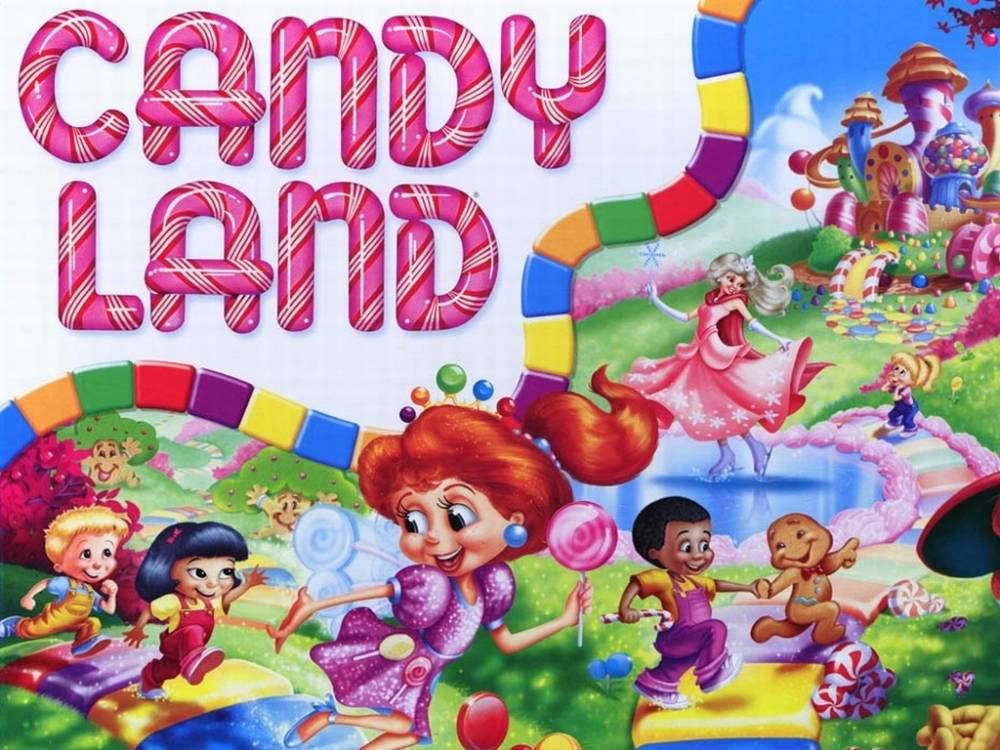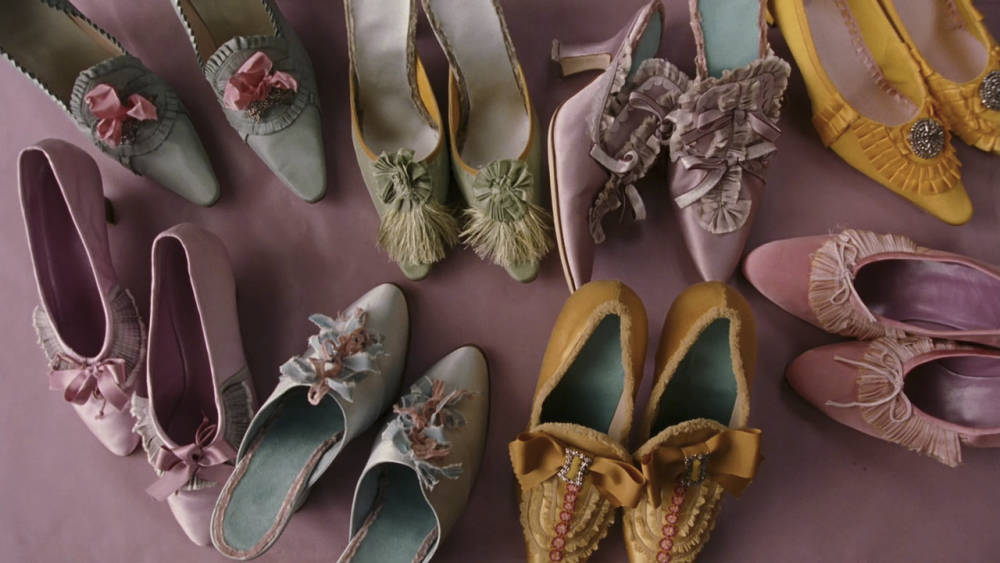
Sugary, sweet and delicious – a trio of colorful adjectives used to describe satiating snacks falling under the category of ‘candy’. These confectionery treats feature sugar as a principal ingredient and encompass a multitude of flavors, colors, tastes and mediums. Whether your dress is made of chocolate wrappers or you have cotton candy hair, if you’re wearing candy cane tights or making delicate paintings of cakes and meringues as light as air, you understand that candy is more than an edible treat, it has become a shared experience and means of cultural identity.
Japanese fashion designer and purveyor of all things avant-garde, Rei Kawakubo has been concocting cotton candy bouffants together with hair guru Julien d’Ys for Comme des Garçons runway shows since the mid-1990s. Beginning with spring/summer 1996’s techno-colored collection, when each model’s head was accessorized with brightly colored wigs seemingly composed of spun sugar, to likeminded confectionery headwear shown in 2009 and 2010, Kawakubo’s female models have often taken on dreamy and delicious visages coupled with avante-garde fashions.
Comme Des Garçons
Spring/Summer 1996
Comme Des Garçons
Spring/Summer 1996
Comme Des Garçons
Spring/Summer 1996
Comme Des Garçons
Fall/Winter 2009
Comme Des Garçons
Fall/Winter 2009
Comme Des Garçons
Fall/Winter 2009
Comme Des Garçons
Spring/Summer 2010
Comme Des Garçons
Spring/Summer 2010
Comme Des Garçons
Spring/Summer 2010
While Rei has employed cotton candy as decorative headwear on a multitude of occasions, American artist Will Cotton has devoted an entire body of work to the study of this fluffy, sugary confection. Cotton’s seductive, pastel landscapes and portraits featuring sweets and baked creations often inhabited by human subjects, merge elements of cultural iconography with childlike imagery ranging from the Candy Land board game and gingerbread houses to ornately decorated cakes, macaroons, cookies and meringues. In 2006, master footwear designer Manolo Blahnik created a selection of 18th century-inspired cotton candy colored heels for Sofia Coppola’s film Marie Antoinette; each ornate design mimicking the delicate, delicious and decorated appearance of the film’s many cakes and other edible treats.

Will Cotton
The Only Paradise is Paradise Lost, 2007

Will Cotton
Cotton Candy Cloud (Sandra,) 2005

Will Cotton
Pastoral, 2009

Manolo Blahnik
Shoes for Marie Antoinette, 2006

Manolo Blanhik
Shoes for Marie Antoinette, 2006

Manolo Blanhik
Shoes for Marie Antoinette, 2006
While cotton candy has been repeatedly elevated into the realm of high fashion and fine art, the cultural appropriation of candy canes, a traditional red and white striped peppermint-flavored stick often associated with the holiday season, runs the gamut from Parisian runways to the pages of iSpy children’s books.
Balenciaga
Fall/Winter 2016
For fall/winter 2016, Denma Gvasalia’s first collection as creative director of Balenciaga, the Georgian designer sent a slew of candy cane-inspired tights down the runway, while in the 1990s, artist Louise Bourgeois produced a series of red and white ‘spiral’ drawings, a number of which give the visual effect of classic candy cane stripes. In 2005, the late California-based artist Mike Kelley produced a kitschy film titled ‘Candy Cane’ which lived as a visual projection as part of a larger installation entitled “Candy Cane Throne”. The short video includes mesmerizing clips of swirling visuals such as pink milk and piles of red and white candy, accompanied by a cheesy soundtrack sung by a young female pop band with lyrics in praise of Candy Canes.
Louise Bourgeois
Spiral, 1994
Mike Kelley
Candy Cane Throne, 2005
For artists and fashion designers whose work taps into the constructs of everyday consumer culture through commonplace iconography, candy wrappers have long proven captivating subject matter. American Pop artist Mel Ramos made waves throughout the latter half of the 20th century through his erotic portraits of scantily clad pinups alongside everyday objects. Ramos’ ‘Candy Women’ portraits depicting naked women emerging from M&M wrappers, snickers bars, boxes of Red Hots, Tootsie Rolls, Life Savers and Butterfingers are some of the artist’s most sought after, identifiable works, all connected through their suggestive imagery sexualizing everyday treats.
Mel Ramos
Baby Ruth, 1981
Mel Ramos
Candy, 1978
Mel Ramos
Butterfinger, 1990
Mel Ramos
Miss Kiss, 2012
Moschino
Fall/Winter 2014
Moschino
Fall/Winter 2014
Moschino
Fall/Winter 2014
Moschino
Fall/Winter 2014
Fashion designer Jeremy Scott took a similar, albeit less seductive approach to ‘candy-as-clothing’ in his fall/winter 2014 collection for Moschino, when the American designer utilized candy iconography and visuals of sugary cereal as patterns on kitschy eveningwear based on the idea of wearable Pop Art.
Andy Warhol
Lifesavers Ad, 1985
In 1985, Andy Warhol produced an Ads portfolio consisting of 10 screen prints of original advertisements each with a distinct visual identity, which included brands ranging from Chanel and Apple, to Paramount, Volkswagen and Lifesavers. Warhol’s deep-rooted, professional connection with all things candy-related predates his 1985 Lifesavers ad, one of Warhol’s early superstars throughout the late 60s and early 70s was American actress and transsexual icon Candy Darling. Darling stared in Warhol’s films ‘Flesh’ and ‘Women in Revolt’ and was the subject of multiple portraits by fellow New York photographer Robert Mapplethorpe.
Robert Mapplethorpe
Candy Darling, 1972
Robert Mapplethorpe
Candy Darling, 1972
Robert Mapplethorpe
Candy Darling
While numerous artists have employed candy iconography in their work, giving allusion to the mere presence of sugary treats, others have chosen to use actual candy as a principal material as opposed to a featured subject matter. One of the foremost works produced by the late, Cuban-born, American visual artist Félix González-Torres, titled “Untitled (Portrait of Ross in L.A.)” (1991), is a 175 pound-pile of candy, typically positioned in the corner of a room, from which visitors are encouraged to take samples. While highlighting candy as a featured medium may convey lighthearted nuances in a work, in actuality, the pile of shimmering wrappers represents the weight of González-Torres’ late partner, Ross Laycock, who died of AIDS in 1991; the participatory nature of this work and the dwindling pile signify the rapid decline of Laycock’s body and health.
Dan Colen
Untitled, Chewing Gum on Canvas, 2010
Félix González-Torres
Untitled, Portrait of Ross in L.A., 1991
If Félix González-Torres’ pivotal 1991 work pushed the boundaries of sculpture through materiality and meaning, then American contemporary artist Dan Colen took similar strides in 2006 when the artist began making paintings with chewing gum instead of paint. These colorful, textured works represent the beginning a significant period in the artist’s career, at which time Colen began exploring the materiality of his medium as opposed to representational subject matter.
Chanel
Fall/Winter 2014
If the actual presence of sugary treats in a scenario is impractical, then the mere illusion to candy must suffice. In 2014, Karl Lagerfeld showed his famed ‘supermarket’ collection for Chanel, set in Chanel-ified convenience store with aisles of branded products and produce. Accessorized atop the season’s layered looks and brightly colored, Memphis-style prints were pastel-colored ceramic necklaces and bracelets simulating the appearance of hard candy necklaces, everyone’s favorite edible baubles. In 1989, Japanese architect and industrial designer Shiro Kuramata took a similar approach towards immortalizing colorful, hard candies with the design of his ‘Panacée’ rug. The carpet’s sporadic pattern was achieved through spreading fruit shaped candies on a photocopier, from which Kuramata made a color copy and used the image to sketch the rug design. The fruit shaped motifs, including apples, bananas, pears and berries, were individually rendered and raised so that anyone walking over the carpet felt a variety of textures, akin to the various flavors provided by the featured candy.


